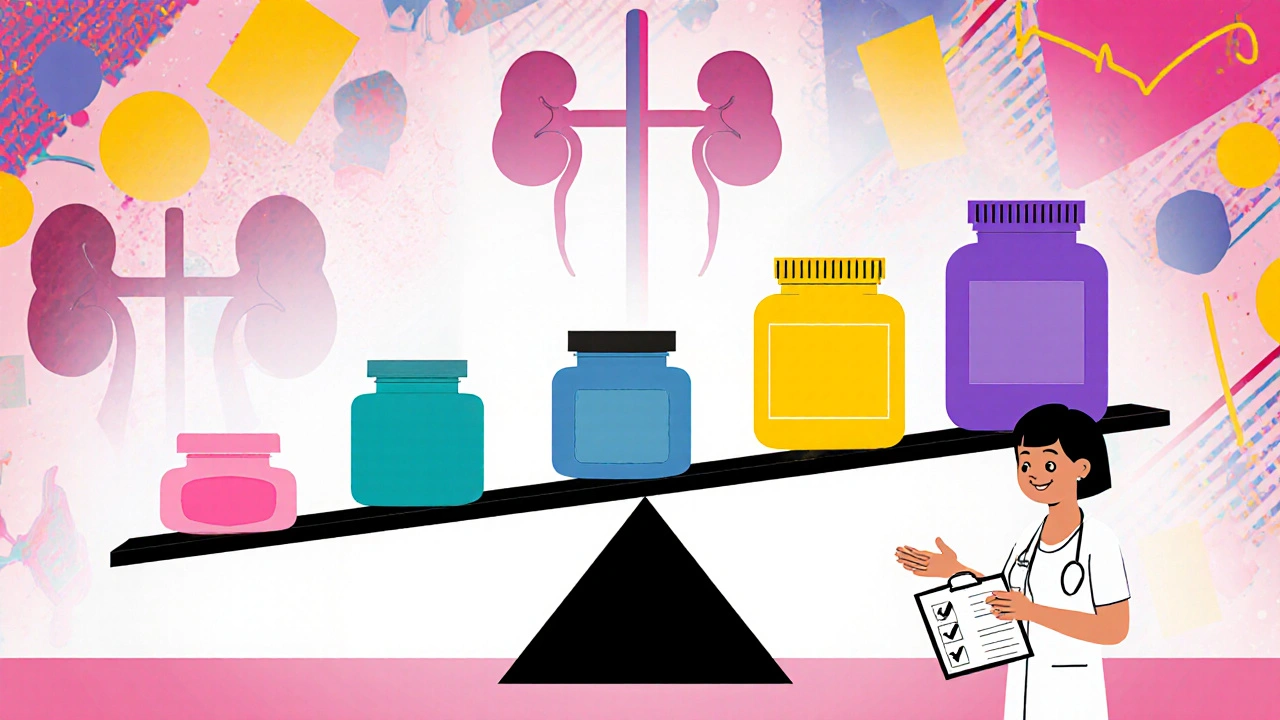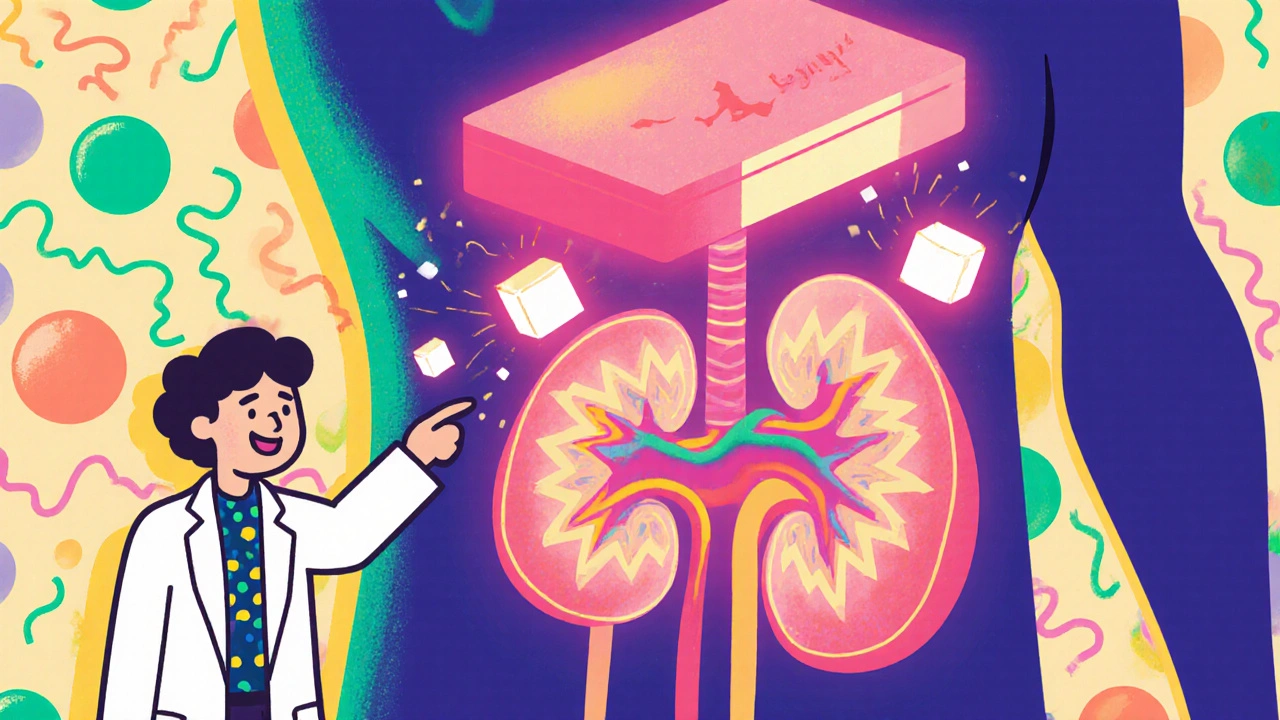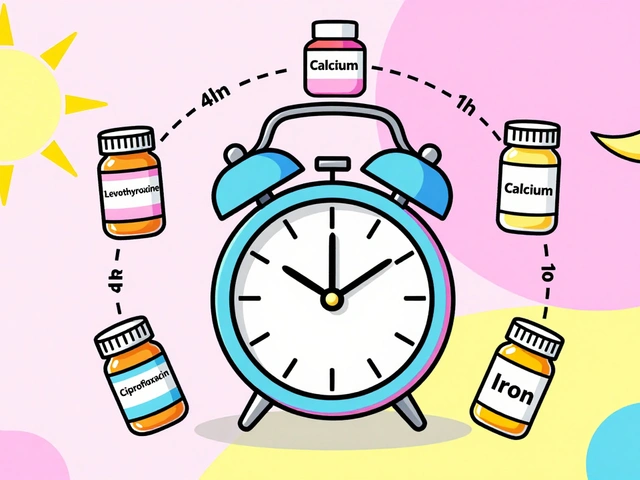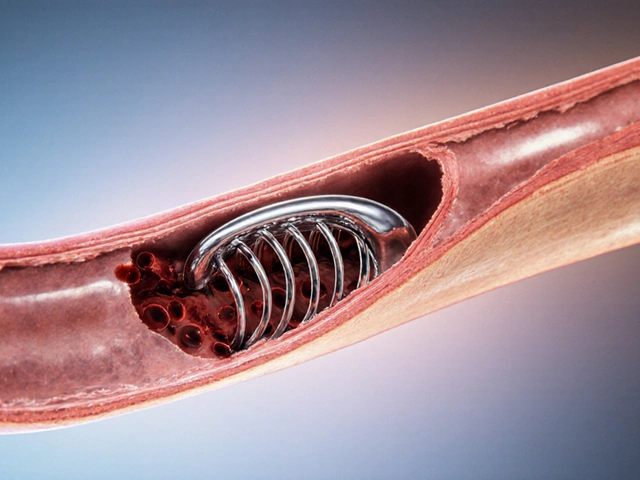Saxagliptin Dose Calculator
About This Tool
This calculator helps determine the appropriate saxagliptin dose based on kidney function (eGFR). Since saxagliptin is primarily cleared by the kidneys (≈80%), reduced kidney function may require dose adjustment to prevent accumulation and side effects.
When treating Type 2 Diabetes a chronic condition marked by high blood sugar and insulin resistance, doctors must keep an eye on the kidneys. The kidneys filter waste, balance fluids, and regulate blood pressure, so any drug that messes with that balance can create problems. saxagliptin, a popular blood‑sugar medicine, sits at the center of a growing conversation about renal safety.
How Saxagliptin Works
Saxagliptin a dipeptidyl peptidase‑4 (DPP‑4) inhibitor approved for managing type 2 diabetes blocks the DPP‑4 enzyme, which normally breaks down incretin hormones. By preserving incretins, it helps the pancreas release more insulin after meals and reduces the amount of glucagon, a hormone that raises blood sugar.
Key attributes of saxagliptin:
- Typical dose: 5 mg once daily.
- Half‑life: ~2.5 hours, but its active metabolite (5‑hydroxy‑saxagliptin) extends the effect.
- Clearance: Primarily renal (≈80%).
Because the kidneys clear most of the drug, any decline in renal function can raise plasma levels, potentially increasing side‑effects.
Why Kidney Function Matters in Diabetes Treatment
Kidney Function the ability of the kidneys to filter blood, usually expressed as glomerular filtration rate (GFR) is a critical safety marker. Diabetes itself is a leading cause of chronic kidney disease (CKD). As GFR falls, the risk of drug accumulation rises.
Clinicians assess renal health using the estimated GFR (eGFR) equation, which incorporates serum creatinine, age, sex, and race. The resulting number places patients into CKD stages:
- Stage 1: eGFR ≥ 90 mL/min/1.73 m²
- Stage 2: 60-89 mL/min/1.73 m²
- Stage 3a: 45-59 mL/min/1.73 m²
- Stage 3b: 30-44 mL/min/1.73 m²
- Stage 4: 15-29 mL/min/1.73 m²
- Stage 5: <15 mL/min/1.73 m² (kidney failure)
Every stage influences how we dose or even whether we prescribe saxagliptin.
Clinical Evidence Linking Saxagliptin to Renal Outcomes
Large trials such as SAVOR‑TIMI 53 (Saxagliptin Assessment of Vascular Outcomes Recorded in Patients with Type 2 Diabetes) enrolled over 16,000 patients, many of whom had mild‑to‑moderate CKD. The study found:
- No increase in the composite renal endpoint (doubling of serum creatinine, end‑stage renal disease, or renal death) compared with placebo.
- A modest rise in albuminuria in a subset, though this did not translate into worse GFR trajectories.
- Patients with eGFR < 30 mL/min/1.73 m² were excluded, so data for severe CKD remain limited.
Post‑marketing surveillance in 2022-2024 identified rare cases of acute kidney injury (AKI) when saxagliptin was combined with diuretics or NSAIDs. The pattern suggests drug‑drug interactions rather than a direct nephrotoxic effect.
Dosing Adjustments Based on GFR
Guidelines from the FDA the U.S. Food and Drug Administration, which regulates prescription medicines and the European Medicines Agency (EMA) recommend the following saxagliptin dosing scheme:
| eGFR (mL/min/1.73 m²) | Recommended Dose | Comments |
|---|---|---|
| ≥ 60 | 5 mg once daily | Standard dose - no adjustment needed. |
| 30-59 | 5 mg once daily | No dose change; monitor renal function annually. |
| 15-29 | 2.5 mg once daily | Reduced dose due to decreased clearance. |
| <15 | Not recommended | Insufficient data; consider alternative therapy. |
For patients on dialysis, clinicians usually avoid saxagliptin altogether and may switch to insulin or a non‑renally cleared agent.
Comparison with Other DPP‑4 Inhibitors
While saxagliptin is heavily renal‑cleared, its peers differ in elimination pathways, which can affect choice in CKD:
| Drug | Renal Clearance % | eGFR < 30 ml/min Adjustment |
|---|---|---|
| Saxagliptin | ≈ 80 % | Half dose (2.5 mg) or avoid <15 |
| Sitagliptin | ≈ 80 % | Reduce to 25 mg daily; avoid <15 |
| Linagliptin | ≈ 5 % (biliary excretion) | No adjustment needed |
| Vildagliptin | ≈ 85 % | Half dose (50 mg) if 30-44; avoid <30 |
| Alogliptin | ≈ 70 % | Half dose (12.5 mg) if <45; avoid <30 |
Because linagliptin is mainly eliminated via the bile, it’s often the go‑to DPP‑4 inhibitor for patients with advanced CKD.

Practical Tips for Clinicians and Patients
- Check eGFR at baseline and at least annually; more often if the patient is on nephrotoxic meds.
- If eGFR falls below 30 mL/min/1.73 m², halve the saxagliptin dose and reassess in 3 months.
- Avoid concurrent high‑dose NSAIDs or loop diuretics without renal monitoring.
- Educate patients to report swelling, sudden weight gain, or decreased urine output - early signs of fluid retention.
- Consider switching to linagliptin or basal insulin if renal function continues to decline.
Remember, saxagliptin’s safety profile remains favorable in mild‑to‑moderate CKD when dosing follows the guideline. The drug’s benefit-improved glycemic control without significant hypoglycemia-often outweighs the modest renal concerns.
Frequently Asked Questions
Can saxagliptin be used in patients on dialysis?
Current labeling advises against saxagliptin in end‑stage renal disease (eGFR < 15 mL/min/1.73 m²) or patients on chronic dialysis. Alternatives such as insulin or linagliptin are preferred.
Does saxagliptin increase the risk of acute kidney injury?
Evidence suggests a very low incidence. Most AKI reports involve concomitant nephrotoxic drugs. Monitoring and avoiding risky combinations mitigate the risk.
How often should renal function be checked while on saxagliptin?
At treatment initiation, then at least once a year. If eGFR is between 30-44 mL/min/1.73 m² or the patient takes other kidney‑affecting medicines, check every 3-6 months.
Is dose reduction necessary for eGFR 30-59 mL/min/1.73 m²?
No. The standard 5 mg daily dose is safe for eGFR ≥ 30 mL/min/1.73 m². Only when eGFR falls below 30 do we halve the dose.
What are the signs of worsening kidney function I should watch for?
Decreased urine output, swelling in ankles or face, sudden weight gain, fatigue, or foamy urine. Any of these warrant a prompt labs check.
Staying proactive about renal monitoring lets you keep the glycemic benefits of saxagliptin while protecting the kidneys.






Ben Bathgate
October 19, 2025 AT 14:21Look, saxagliptin is mostly dumped by the kidneys, so if your eGFR is slipping you’re basically loading up on the drug. That means higher plasma levels and a bigger chance of nasty side effects like pancreatitis or heart failure. Doctors need to drop the dose or switch meds once you dip below a 45 mL/min GFR. Ignoring that is just sloppy prescribing. If you’re not monitoring renal function every few months, you’re playing roulette with your patients.
Christian Georg
October 19, 2025 AT 15:20For anyone starting saxagliptin, the key is to check the eGFR before the first prescription and then at least annually thereafter 😊. If the eGFR is ≥ 60 mL/min, the standard 5 mg dose is fine. Between 45‑59 mL/min you can keep the same dose but watch for any signs of fluid retention. Below 45 mL/min you should consider a 2.5 mg dose or switch to a drug that’s not renally cleared. Also, remember that the active metabolite sticks around longer, so dose adjustments need a bit of patience. Keeping the kidneys happy keeps the blood sugar in check.
Christopher Burczyk
October 19, 2025 AT 18:06Saxagliptin, a selective dipeptidyl peptidase‑4 inhibitor, has been extensively evaluated for its renal safety profile.
The majority of the administered dose-approximately 80 %-is eliminated unchanged via glomerular filtration.
Consequently, a reduction in glomerular filtration rate directly influences systemic exposure to both the parent compound and its active metabolite, 5‑hydroxy‑saxagliptin.
Pharmacokinetic analyses indicate that patients with an estimated GFR of 30 mL/min/1.73 m² experience roughly a two‑fold increase in area under the curve compared with individuals possessing normal renal function.
This elevation in exposure correlates with an increased incidence of adverse events, particularly those affecting the cardiovascular and pancreatic systems.
Clinical guidelines therefore recommend dose modification once the eGFR falls below 45 mL/min/1.73 m².
In practice, the standard 5 mg once‑daily regimen is maintained for eGFR values of 45 mL/min/1.73 m² or greater, while a reduced dose of 2.5 mg is advised for eGFR values between 30 and 44 mL/min/1.73 m².
Patients with end‑stage renal disease (eGFR < 15 mL/min/1.73 m²) should generally avoid saxagliptin in favor of agents with hepatic clearance.
Ongoing monitoring of renal function is essential, with re‑assessment recommended at three‑month intervals for patients experiencing a rapid decline in GFR.
Moreover, clinicians must remain vigilant for signs of fluid overload, a known risk associated with DPP‑4 inhibition in compromised renal states.
The interplay between saxagliptin and other nephrotoxic medications, such as non‑steroidal anti‑inflammatory drugs, further necessitates cautious co‑prescribing.
When initiating therapy, baseline measurements of serum creatinine, albuminuria, and blood pressure provide a comprehensive picture of renal health.
Should any adverse renal markers emerge, dose reduction or discontinuation must be promptly enacted to mitigate toxicity.
Ultimately, individualized dosing predicated on accurate eGFR estimation optimizes therapeutic benefit while minimizing harm.
Adherence to these evidence‑based recommendations ensures that saxagliptin remains a viable option for glycemic control in the context of diverse renal function profiles.
Nicole Boyle
October 19, 2025 AT 20:53From a nephrology standpoint, the pharmacodynamic interplay of saxagliptin's inhibition of DPP‑4 with endogenous incretin pathways becomes particularly salient when the renal clearance vector shifts. In CKD stage 3a–b, the tubular secretion component diminishes, amplifying the area under the plasma concentration‑time curve (AUC). This pharmacokinetic perturbation necessitates a recalibration of the dosing algorithm, ideally integrating the Cockcroft‑Gault‑derived creatinine clearance as a corrective factor. Moreover, the metabolite 5‑hydroxy‑saxagliptin exhibits a protracted half‑life, compounding exposure under reduced glomerular filtration. Consequently, therapeutic drug monitoring, though not routinely performed, could be advantageous in borderline eGFR scenarios to preempt adverse events.
Maridel Frey
October 19, 2025 AT 23:40When prescribing saxagliptin, it is prudent to align the dosing strategy with the patient’s current eGFR category. For individuals whose eGFR is 60 mL/min/1.73 m² or higher, the conventional 5 mg once‑daily dose is appropriate. If the eGFR falls within the 45–59 mL/min/1.73 m² range, the same dosage can be continued, but clinicians should schedule more frequent renal assessments. For eGFR values between 30 and 44 mL/min/1.73 m², a reduced dose of 2.5 mg daily is recommended to avoid drug accumulation. Patients with eGFR below 30 mL/min/1.73 m² should be evaluated for alternative therapies, as the risk–benefit ratio becomes unfavorable. Maintaining open communication with patients about the importance of kidney monitoring can improve adherence and outcomes.
Jay Kay
October 20, 2025 AT 02:26Wow. Saxagliptin and kidneys? That’s a disaster waiting to happen if you ignore the numbers. One tiny slip in GFR and you’re flooding the bloodstream with extra drug. It’s like pouring gasoline on a fire. Dose cut is the only sensible move when the kidneys start to fail.
Rakhi Kasana
October 20, 2025 AT 05:13Saxagliptin’s renal clearance is a double‑edged sword – it works great while the kidneys are healthy, but once they falter the drug hangs around longer than it should. The consequence is an amplified risk of side‑effects, especially in patients already battling diabetes‑related complications. Adjusting the dose isn’t just a recommendation; it’s a necessity to keep the therapeutic window safe. Keeping an eye on eGFR trends can save a lot of trouble down the line.
Sarah Unrath
October 20, 2025 AT 08:00so u got saxagliptin it clears thru kidneys mostly if u have low gfr u get more drug in blood gotta cut dose or stop it its simple dont ignore it
James Dean
October 20, 2025 AT 10:46In the quiet rhythm of the body the kidney whispers its limits and the drug must listen. When the filter slows the medicine lingers, a reminder that even chemistry yields to biology. Adjusting a pill becomes a meditation on balance and respect for the hidden work of filtration.